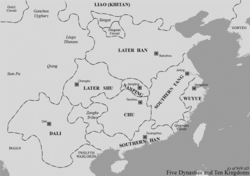Han 漢 | |||||||||||
|---|---|---|---|---|---|---|---|---|---|---|---|
| 947–951 | |||||||||||
 Later Han | |||||||||||
| Capital | Bian (Kaifeng) | ||||||||||
| Common languages | Chinese | ||||||||||
| Religion | Buddhism, Taoism, Confucianism, Chinese folk religion | ||||||||||
| Government | Monarchy | ||||||||||
| Emperor | |||||||||||
• 947–948 | Emperor Gaozu | ||||||||||
• 948–951 | Emperor Yin | ||||||||||
| Historical era | Five Dynasties and Ten Kingdoms Period | ||||||||||
• Established in Taiyuan | March 10, 947 | ||||||||||
| January 1; January 2, 951 | |||||||||||
| February 13 951 | |||||||||||
| Currency | Chinese cash, Chinese coin, copper coins etc. | ||||||||||
| |||||||||||
| Today part of | China | ||||||||||
| Part of a series on the |
| History of China |
|---|
Han, known as the Later Han (simplified Chinese: 后汉; traditional Chinese: 後漢; pinyin: Hòu Hàn) in historiography, was a short-lived imperial dynasty of China that existed from 947 to 951. It was the fourth of the Five Dynasties during the Five Dynasties and Ten Kingdoms period in Chinese history, and the third consecutive Shatuo-led Chinese dynasty,[1] although other sources indicate that the Later Han emperors claimed patrilineal Han ancestry.[2] It was among the shortest-lived of all Chinese regimes, lasting for slightly under four years before it was overthrown by a rebellion that resulted in the founding of the Later Zhou dynasty. Remnants of the Later Han then founded the Northern Han dynasty.
- ^ Mote, Frederick W (2003). Imperial China 900–1800. pp. 12–13.
- ^ According to Old History of the Five Dynasties, vol. 99, and New History of the Five Dynasties, vol. 10. Liu Zhiyuan was of Shatuo origin. According to Wudai Huiyao, vol. 1 Liu Zhiyuan's great-great-grandfather Liu Tuan (劉湍) (titled as Emperor Mingyuan posthumously, granted the temple name of Wenzu) descended from Liu Bing (劉昞), Prince of Huaiyang, a son of Emperor Ming of Han